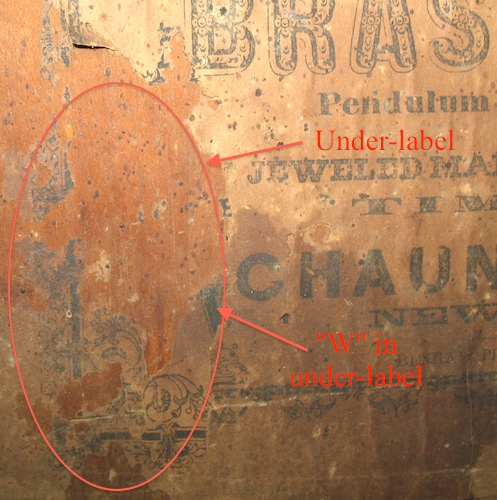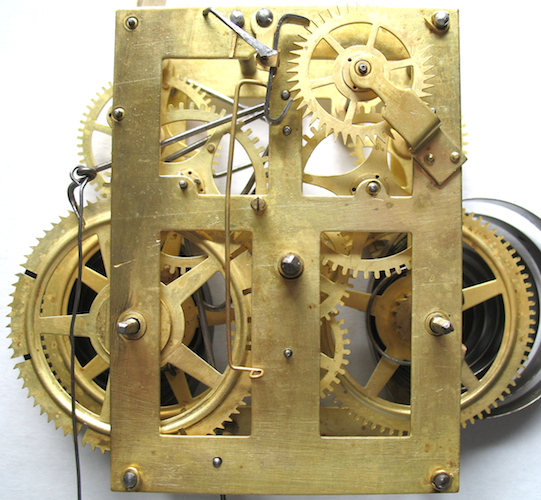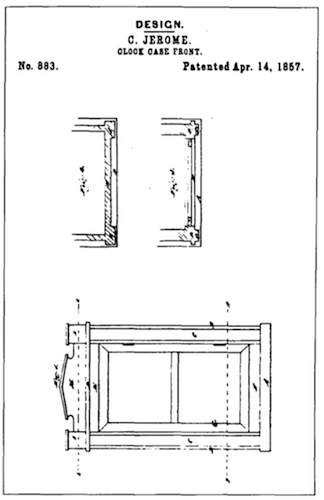I’m going to devote a little more explanation to this clock than I normally do, because I believe it represents a tragic and very important period in Jerome’s life. First, a bit of history, courtesy of Jerome’s autobiography and Chris Bailey’s Rags to Riches. In February of 1856, the Jerome Manufacturing Co. declared bankruptcy. At the time, Jerome was the largest clock maker in the US and quite likely the world. Chauncey Jerome’s personal wealth was entirely tied up in the company. He was left with only his name (which was being dragged through the mud in the press by P. T. Barnum) and royalties he was receiving for the use of his name from his son-in-law, Edward Stevens, in England. Looking for a means of making a living, in the fall of 1856 he followed his brother, Noble, to Waterbury to work for Benedict & Burnham (founders of the Waterbury Clock Co.). Benedict & Burnham were original shareholders when the Jerome Manufacturing Co. was incorporated in February 1850, but they sold their shares around 1853 and were not entangled in the bankruptcy (although they may have been creditors). Chauncey was hired by Benedict & Burnham to set up the case-making shop for the company. While there, he designed a clock case, for which he was issued patent #883 on April 14, 1857 (see below for the patent drawing). To the best of my knowledge, the only other patent he received was for a cigar box, and that was issued posthumously. During the spring of 1857, Jerome was lured away (he referred to it as “a first-rate offer”) by Wm. L. Gilbert to work in a new factory he had started using in Ansonia. Jerome was to oversee construction of several thousand of the patent cases. Gilbert’s main operations were in Winchester (also known as Winsted). Jerome’s time with Gilbert was unpleasant. Gilbert refused to sign a contract for Jerome’s services, and Jerome naively continued to work at the factory, even sinking his own money in the business (to the tune of $1900). It is the fact that Jerome was putting his money into the business that suggests to me that the lure that Gilbert dangled in front of him was a partnership of some type. Clearly, it would not have been a major stake in the firm, but I find it hard to believe that a common employee (even if Jerome was not “common”) would pay into the business. Chris Bailey says as much, in that “Gilbert promised Jerome an interest in this business…” Gilbert never delivered on that promise. Jerome left Gilbert’s employ after eight months.
Jerome patent cases are found with the labels of numerous makers. According to Chris Bailey:
“These cases came in at least two sizes and are found with labels of Chauncey Jerome, William L. Gilbert & Company, Chauncey Jerome for Benedict & Burnham, Waterbury Clock Company, and others. Gilbert movements have been found in cases labelled Chauncey Jerome, and Waterbury labelled cases have been found with Waterbury Clock Co. production movements stamped ‘Chauncey Jerome.’”
Adding to what Chris said, there were three basic sizes: a small version for spring-driven movements; a medium-sized version for 30-hr, weight-driven movements; and a large version for 8-day, weight-driven movements. Interestingly enough, small versions made by different makers are not necessarily the same size. My Waterbury Jerome patent case is roughly one inch shorter than the clock that’s the subject of this post. As far as movements go, we can add those of A.S. Platt & Co., the New Haven Clock Co., and Ansonia to the list.
Now for the clock and the pieces of the puzzle. As indicated above, the clock is the small Jerome patent case (21.5” tall). Nearly everything about it appears to be original, although the thin cap to the pediment (similar to the caps on the flanking blocks) is missing, and the hands are suspect. The upper glass is in wonderful condition, and the lower tablet, while original, has been rubbed nearly to extinction.
The over-pasted Chauncey Jerome (of New Haven, Conn.) label was printed by Benham, of the Glebe Building, in New Haven. Based on New Haven City directories, Benham moved to the Glebe Building sometime between June of 1855 and June of 1856. The label is unlike any other Benham label found in Jerome clocks. Fragments of the under label are visible at the bottom left and right.
Printer’s line on the Jerome label.
A crucial clue is part of a bold “W” peeking out from under the over-paste.
Front view of the early Ansonia 30-hr time & strike movement. There is no evidence to suggest the clock had any other movement in it. Features found only on early Ansonia movements, as well as on those of Terry & Andrews (the firm that Ansonia succeeded), include the escape wheel bridge with a square foot and the elegantly spoked #2 and #3 wheels on both the time and strike trains.
Rear view of the Ansonia movement.
Drawings for Patent #883 issued to Chauncey Jerome on April 14, 1857.
What did these details suggest to me in terms of production history of the clock? The “W” on the under label was at least consistent with Wm. L. Gilbert & Co. Additionally, Ansonia movements have been reported in Gilbert clocks.
The key finding that allowed me to definitively fit all of the pieces together was an ebay listing for a Gilbert clock with a Jerome patent case. The clock had the same 30-hr Ansonia movement as mine. The upper glass had the same design, though with a different color scheme. The same upper glass design has also been reported on the NAWCC message board in another Jerome patent case with a Gilbert (not Ansonia) 30-hr, spring-driven movement. The label on the ebay clock had wording identical to the wording on my Jerome label: “EIGHT-DAY & THIRTY-HOUR/BRASS CLOCKS/Pendulum Clocks of a variety of Styles/AND SOLE MANUFACTURERS OF/STONE JEWELED MARINES, AND EIGHT-DAY GILT GALLERY/TIME PIECES.” At the bottom was the maker’s name, WM. L. GILBERT & CO., in the same font as seen on the under label of my clock. The border pattern on the Gilbert clock is the same as the border of the under label on mine.
So, what does the puzzle reveal? This clock was made while Jerome worked for Gilbert for eight months in 1857-1858. If Jerome’s account is correct, Gilbert didn’t pay him for his work, but instead took advantage of Jerome’s name by selling clocks with his (Jerome’s) name on them. Notice that the label places Jerome in New Haven, despite the fact that he was living in Ansonia (where the clock was made). The Jerome name and New Haven were associated together world-wide. Putting the two together on this label was a way of furthering the fiction of this being a true Jerome. The back-story to this clock is that it has a direct personal connection to Jerome, in terms of the patent and his oversight in the construction of the case, and ultimately in the betrayal of Jerome by Gilbert. There may be far more connection between this clock and Jerome than all but the earliest clocks he was making when he first got into the business more than 30 years earlier. If it seems a stretch to say that this clock has more connection to Jerome than the ones he was involved in just a year prior at Waterbury, I’d argue that there is a difference. To Jerome, this “first-rate offer” by Gilbert was his chance to re-establish his name as a “Clock Maker.” At Waterbury, Jerome was simply hired to set up the case-making shop; he never had a personal stake in the business.
I can probably be accused of overly romanticizing this particular clock. While in production, it had no greater significance to Jerome than any of the other thousands of these patent cases being made. But looking back on how Jerome’s career came to a devastating halt with his bankruptcy, followed by fitful attempts to rehabilitate his name and reputation, and the abuse he received first by Gilbert and then by Joseph Remer, I believe this clock (and others like it) represent a tragic period in his life, one that he truly never overcame.
I’ll close by noting that not all parts of this puzzled have been solved. What is the significance of the sequencing indicated by the Jerome over-pasted label? This clock started life as a labeled Gilbert product and was then re-labeled as a Jerome. This change occurred prior to assembly of the case. The Jerome label is under the vertical rails; it was not cut to fit the backboard after assembly. Was this clock under construction before Gilbert enticed Jerome away from Waterbury? And why is there no paper strip on the back of the door touting the patent date for the clock case? It’s possible that the clock was made prior to the issuance of the patent, although given that Jerome moved to Ansonia in the spring of 1857, the timing is very tight. Some mysteries may never be solved.






